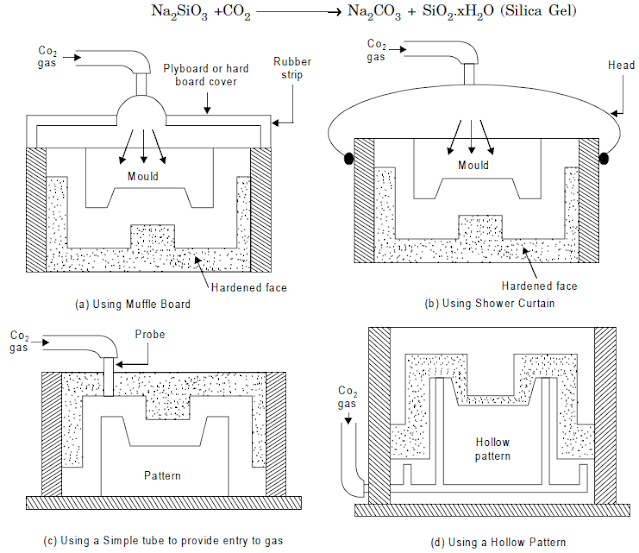MOLDING METHODS
Commonly used traditional methods of molding
are bench molding, floor molding, pit molding and machine molding. These
methods are discussed as under.
Bench Molding
This type of molding is preferred for small
jobs. The whole molding operation is carried out on a bench of convenient height. In this
process, a minimum of two flasks, namely cope and
drag molding flasks are necessary. But
in certain cases, the number of
flasks may increase depending upon the number of parting surfaces
required.
Floor Molding
This type of molding is preferred for medium
and large size jobs. In this method, only drag portion of molding flask is used
to make the mold and the floor itself is utilized as drag and it is usually performed with dry sand.
Pit Molding
Usually large castings are made in pits
instead of drag flasks because of their huge size. In pit molding, the sand
under the pattern is rammed by bedding-in process. The walls and the bottom of the pit are usually
reinforced with concrete and a layer of coke is laid on the bottom of the pit to enable easy escape of
gas. The coke bed is connected to atmosphere through vent pipes which provide
an outlet to the gases. One box is generally required to complete the mold,
runner, sprue, pouring
basin and gates are cut in it.
Machine Molding
For mass production of the casting,
the general hand molding technique
proves un economical and in efficient. The main
advantage of machine molding, besides the saving of labor and working time, is the accuracy and
uniformity of the castings which can otherwise be only obtained with much time
and labor. Or even the cost of machining on the casting can be reduced
drastically because it is possible to maintain the tolerances within narrow
limits on casting using machine molding method. Molding machines thus prepare
the moulds at a faster rate and also eliminate the need of employing skilled
molders. The main operations performed by molding machines are ramming of the
molding sand, roll over the mold, form gate,
rapping the pattern and
its withdrawal. Most of the
mold making operations are performed
using molding machines.
Loam Molding
Loam
molding uses loam sand to prepare a loam mold. It is such a molding process in
which use of pattern is avoided and hence it differs from the other molding
processes. Initially the loam sand is
prepared with the mixture of molding sand and clay made in form of a paste by suitable addition of clay water. Firstly
a rough structure of cast article is made by hand using bricks and loam
sand and it is then given a desired shape by means of strickles and sweep patterns. Mould is thus prepared.
It is then baked to give strength to resist the flow of molten metal. This method of molding is
used where large castings are required in numbers. Thus it enables the
reduction in time, labor and material which would have been spent in making a
pattern. But this system is not popular for the reason that it takes lots of time in preparing mould and requires
special skill. The cope and drag part of mould are constructed separately on two different
iron boxes using different sizes of strickles and sweeps etc. and are assembled together
after baking. It is important to note that loam moulds are dried slowly and completely and used for large regular shaped
castings like chemical pans, drums etc.
Carbon-Dioxide
Gas Molding
This
process was widely used in Europe for rapid hardening the molds and cores made
up of green sand. The mold making process is similar to conventional molding
procedure accept the mould material which comprises of pure dry silica sand
free from clay, 3-5% sodium
silicate as binder and moisture content
generally less than 3%. A small amount of starch may be added to improve the green compression strength and a
very small quantity of coal dust, sea coal, dextrin,
wood floor, pitch, graphite
and sugar can also be added to improve the collapsibility of the molding sand. Kaolin
clay is added to promote mold stability. The
prepared molding sand is rammed around the pattern in the mould
box and mould is prepared
by any conventional technique. After packing, carbon
dioxide gas at about 1.3-1.5 kg/cm2 pressure
is then forced all round the mold
surface to about 20 to 30 seconds using CO2 head
or probe or curtain as shown in Fig. 12.14. The special pattern can also be
used to force the carbon dioxide gas all round
the mold surfaces. Cores can be
baked this way. The sodium silicate
presented in the mold reacts with CO2 and produce a very hard constituents or
substance commonly called as silica gel. This hard substance is like cement and helps in binding the sand grains. Molds and cores thus prepared can be used for pouring molten metal for production of both ferrous and non- ferrous casting. The operation is quick, simple require semi-skilled worker. The evolution of gases is drastically reduced after pouring the thus prepared mould.
 |
| Carbon dioxide molding |

Clearly, It is an engaging article for us which you have provided here about Laminate Floor Northern Beaches. This is a great resource to enhance knowledge about it. Thank you. Laminate Floor Northern Beaches
I like this article. I was searching on the search engine and found your blog. I get more knowledge and I read a lot of interesting content here. keep doing it.
Floor care company in Qatar
It’s a great pleasure reading your post. It’s useful information. Probing for the pet blowmoulding machine online then, cruairgas.com is here to guide you.